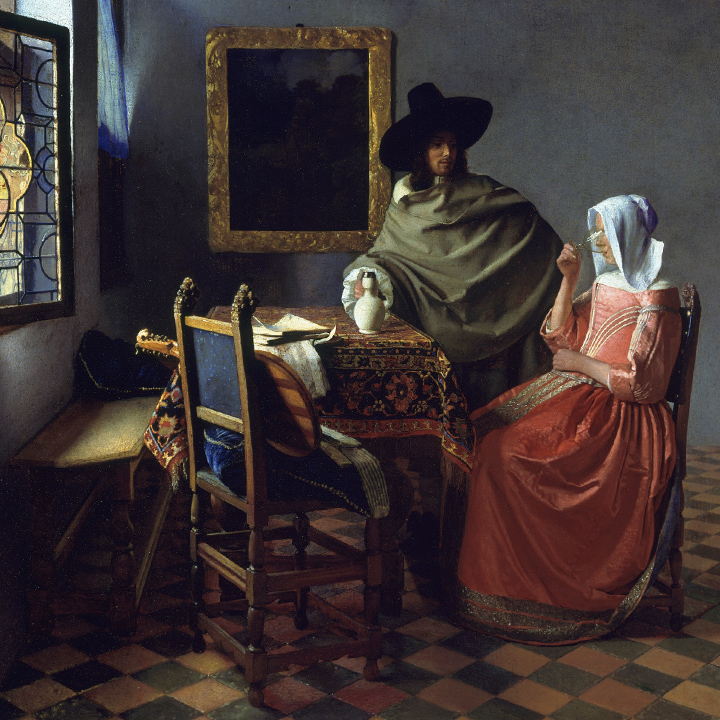Our story begins with 17th century painter Johannes Vermeer. He is known for the photorealistic detail in his paintings and his use of light and color. The mystery is, did he (and other old world masters as far back as the early 1400s) use optical projections or some otherwise unknown devices to paint their masterpieces.
Don’t misunderstand, here is no argument that painters such as Vermeer had a great sense of composition and immeasurable creative talent—it’s just interesting to ponder the theories (and some credible evidence) that they did use techniques and devices that were hitherto unknown.
The players include, first, Johannes Vermeer
To get oriented, here’s a website dedicated to Johannes Vermeer and 17th Century Life in Delft (South Holland) compiled by art historian Drs. Kees Kaldenbach. (It includes his in depth academic essay Vermeer & Visual Perception.)
Johannes Vermeer and 17th Century Life in Delft…
Steadman, Hockney, and Falco
The questioning really ramped up in 2001 with the publication of two books: Architect Philip Steadman’s Vermeer’s Camera and artist David Hockney’s Secret Knowledge: Rediscovering the Lost Techniques of the Old Masters. Hockney collaborated with physicist Charles M. Falco to formalize The Hockney-Falco Thesis. Though others had speculated about the idea of projections, Steadman, Hockney, and Falco brought credible data and a formal theory to the table.
A three part interview of David Hockney by Charlie Rose…
The BBC’s version of Secret Knowledge…
Thorpe and Jenison
What follows is even more interesting. Enter Tim Jenison, an inventor and computer graphics guy (not a painter). In high school Jenison recalls an exchange with his art history teacher, Mr. Thorpe, in which Jenison asked, “These guys are basically trying to make color photographs, aren’t they?”—Mr. Thorp took offense and that stuck with him.
The rest is art history.
Years later after reading Hockney’s book, Jenison saw, in person, a Vermeer at the Rijksmuseum in Amsterdam and it clicked—he thought “I think I see how he did it.” And he set about proving it. Not with diagrams and data, but by painstakingly recreating Vermeer’s space and fabricating the device he envisioned the painter using—a simple mirror on a bar that, to everyone’s surprise, allowed him to, as he describes it, “Trace both shapes and colors.”
Jillette and Teller
Finally on the scene are masters of mystery and magic Pen Jillette and Raymond Joseph Teller—Penn and Teller. As Jenison tells it, Penn (a long time friend), looking for an opportunity to have a conversation about anything but show business, politics, or work, invited Jenison to a meal during which Jenison shared his intention to recreate Vermeer’s process and product. His idea was to build the studio, the set, and the tools and record some of it for a YouTube video. Jillette had a different idea: why not pitch it to one of the movie studios as a full blown documentary. And they did.
The name of the film is Tim’s Vermeer and it was released in 2013 by Sony Pictures to rave reviews—Penn Jillette narrates and Teller directs.
If you enjoy a mystery, slight-of-hand, tempered with a the chill or two—these are books worth reading, interviews worth watching, and a film worth seeing.
Here’s the movie trailer:
Leo Laporte interviews Tim Jenison about the film, episode 118 of his program Triangulation, shortly after the first showings of the film in September of 2013. (Computer graphics aficionados: Watch the whole interview, it’s quite interesting.)
Leo Laporte interviews Tim Jenison (the Vermeer portion begins at minute 34:30)…
From The Guardian: So they used optics, who cares?
Teller’s dad
One bonus of piecing this story together was getting to know Penn and Teller a little better—they are fascinating characters. Teller’s father, interestingly, was a commercial artist he wrote book about him back in 2000 titled, “When I’m Dead All this Will Be Yours: Joe Teller—a portait by his kid, Teller.”
Teller talks about his father…
The book is available from Amazon.
When I’m Dead All this Will Be Yours…
Posted in JUNE 2018 / Chuck Green is the principal of Logic Arts, a design and marketing firm, a contributor to numerous magazines and websites, and the author of books published by Random House, Peachpit Press, and Rockport Publishers. Contact.




Thoughts?